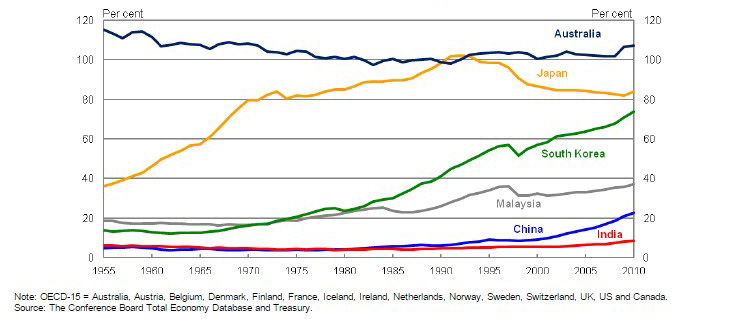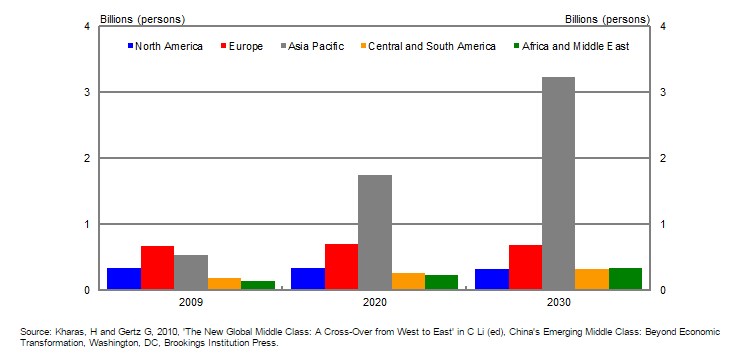It’s a green light from Treasury Secretary Martin Parkinson. His speech last Thursday spells good news for Australian public relations practitioners. Commentary in much of the media has seized on the top official’s comments to focus on issues such as Australia’s lack of productivity and the debate for and against selling Australian assets, but one of his key messages was the rise-and-rise of China and India would have impacts on Australia that will be “sustained” and “profound”.
The speech is an easy read (Sustaining Growth in Living Standards in the Asian Century), and in part states:
“Together, China and India account for around one-third of the world’s population, yet in 1990 they accounted for less than 10 per cent of the world’s GDP. Economic reforms and opening to the rest of the world that commenced in both countries in the later part of last century has seen them move to around 20 per cent of world GDP today, in a period when world GDP itself nearly doubled. On some projections, China and India are expected to comprise around one-third of world GDP by 2030.
Australians know intimately one of the consequences of this massive shift in the centre of economic gravity back towards Asia – the industrialisation and urbanisation underway in a number of countries in the region, but particularly in China, has driven our terms of trade to 140 year highs.”
In other words, we are in the right place at the right time. And then:
“…short of major social dislocation or global geo-strategic tensions it is hard to believe that the industrialisation and urbanisation currently underway in both countries does not have many years to run. Let me be clear, I am not suggesting that China’s growth path will be without volatility, but rather that viewed through the prism of history, this will look like cycles around a strong trend in growth. This means the impacts on Australia will be sustained and profound.”
For Australian Public Relations practitioners, more than our colleagues in other parts of the world, this is good news. Parkinson’s paper contains graphs that starkly illustrate his point; the emergence of an enormous middle class hungry for consumer goods and knowledge.
Chart 1: GDP per capita (Per cent of OECD -15 average)

Note: OECD-15 = Australia, Austria, Belgium, Denmark, Finland, France, Iceland, Ireland, Netherlands, Norway, Sweden, Switzerland, UK, US and Canada. Source: The Conference Board Total Economy Database and Treasury.
“This poses a source of new opportunity for Australia – a massive potential market for our exports, especially knowledge based exports like education and high-end manufacturing; services like tourism; and rural commodities.” Add Public Relations to the knowledge based professions.

Source: Kharas, H and Gertz G, 2010, ‘The New Global Middle Class: A Cross-Over from West to East’ in C Li (ed), China’s Emerging Middle Class: Beyond Economic Transformation, Washington, DC, Brookings Institution Press.
This massive emerging middle class creates huge problems in terms of consumption of non-renewables and green house gases (read Thomas Friedman’s wonderful book: Hot, Flat and Crowded).
But also terrific opportunities. In April this year, at the IPREX regional conference in Hong Kong, it was made very clear that Public Relations is in its infancy in China and the Chinese would become increasingly interested in learning from advanced countries like Australia the art of Public Relations.
In many Asian countries there are strong cultural barriers to business practices that we now accept as the norm, such at worker participation in management (and the need for good internal communications) and openness and transparency in business (and the need for public relations). There are literally hundreds of examples of the catch up before Asian cultures utilise Public Relations as we do in the west; Chinese journalists’ ‘red envelope’ culture (cash for comment) is one example; and in Japan, in time I believe westerners will learn that a root cause of the Fukushima disaster lies in that country’s very traditional (for Westerners, outdated) management practices. Again, an opportunity for Crisis Public Relations practitioners.
The golden age of journalism, particularly TV journalism, in the west was the last thirty years of the last century. Some of us made the switch to the ‘dark side’ when we saw what was coming – a golden age for Australian Public Relations.



